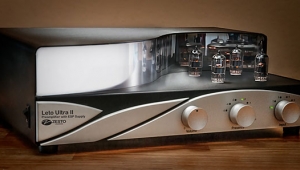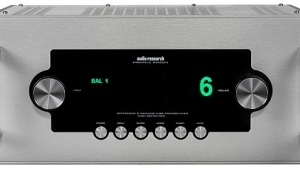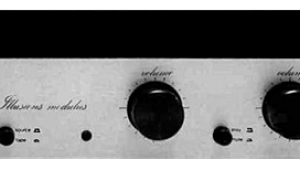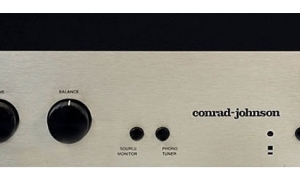| Columns Retired Columns & Blogs |
Convergent Audio Technology SL1 Renaissance preamplifier Page 2
In any case, I think the name Stevens has come up with for this newest SL1 is a good one. The literal meaning of renaissance is rebirth, and the word has very positive historical and cultural resonances. (In retrospect, certain early solid-state amplifiers might have been more accurately named "Dark Ages.") And unlike the previous revisions of the SL1, the Renaissance involves not only refinements of the circuitry and improvements in parts, but some useful new features.
In earlier SL1s, the line stage had 26dB of gain. This worked well with most amplifiers and with typical box, planar, and electrostatic loudspeakers. However, the gain was not optimal for highly sensitive horn loudspeakers, which required that the volume control be set near the bottom of its range. The control of volume in that part of the range was in large steps (the volume control uses discrete resistors); I often wished for an in-between step. To deal with this issue, the Renaissance has two switches (for the left and right channels) on the circuit board, which permit selection of High (26dB) or Low (15dB) gain. I used the Low Gain mode, which permitted the volume control to be set at around 12 o'clock for normal listening, as well as finer adjustments of volume control.

The second new feature is called A/V Bypass. When the preamp is off, the Line 1 inputs are connected via a relay to the A/V outputs (which, somewhat confusingly, are referred to as Main Out 2 in the manual). As Ken Stevens explained it to me in an e-mail, this allows "saving tube life while the kids are watching TV." The way this would work in a typical home-theater system is that the A/V preamplifier- processor or receiver would still control the volume for all channels when you were watching movies, etc., but the front left and right channels would be routed through the Renaissance, which acts in pass-through mode when turned off. Volume control of the front L/R channels would revert to the Renaissance when it was turned on and the input switched to CD or Phono. It's an ingenious arrangement for providing a choice of purist two-channel audio and multichannel home theater in the same system. A second set of outputs, labeled Direct (Main Out 1 in the manual), lacks a relay in the circuit path—a still more purist approach that potentially could benefit sound quality.
A new feature likely to be of great interest to hard-core audiophiles of the vinyl-loving variety is the Renaissance's switch-selectable, low-gain (11dB), moving-coil transformer. According to Stevens, the Ultimate phono stage was already the quietest tube phono stage in the world (!), so there was no need for a high-gain transformer. Using a low-gain transformer allowed for a more optimal match with cartridges that have a high internal impedance, resulting in greater bandwidth and lower distortion across the audioband.
In the areas of parts selection and design execution, the Renaissance includes some important improvements over the Ultimate. A new circuit-board layout allowed the solder mask to be eliminated from all signal traces. This mask is the green material covering traces on a printed-circuit board, and it's characterized by having high dielectric absorption (DA)—a cause, Stevens says, of nonlinear distortion, with resulting veiling and loss of dynamic nuance. In this case there are actual changes in measurable performance: although the circuit itself is identical, the Renaissance's bandwidth extends to 800kHz, compared to 600kHz for the Ultimate. Stevens is careful to point out that he's not claiming that the difference between 600 and 800kHz is actually audible; it merely indicates the lower DA, and it's the reduction of DA that can be heard within the audioband.
There's also been a slight improvement in the power supply, and the circuit-board material has been changed to G30 (polyimide) from something called G200. The changes in layout and board material were done at the same time, so it's hard to determine which change has resulted in which sonic improvement. Stevens notes that although G200 and G30 have the same electrical specs, "perhaps the G30 simply sounds better." Alas, Stevens has made too many changes in his basic design—different circuit board, MC transformer, gain switches, A/V Bypass relay—to permit upgrading an Ultimate to Renaissance specs. The price has been increased by $2000 (or by $1000 for the line-stage-only version).
Setup
In evaluating a preamplifier, which by definition can work only as one part of an audio system, one of the contentious issues is the matter of associated components. The manufacturer of a product being reviewed is often more than willing to make suggestions about the choice of associated gear. Sometimes these suggestions have a solid technical basis (eg, a speaker presents a low impedance and must be used with an amplifier that can handle such a load), while at other times they represent the manufacturer's knowledge of subtle component interactions that can have a positive or a negative effect on sound quality. (Occasionally a manufacturer's recommendations represent industry politics, but we won't go there.)
While I want to give each component I review its chance to shine, I don't want to change the system in some other way that might change the system's sound in and of itself. To this end, unless there are compelling technical reasons to do so, I'm reluctant to change cables to a manufacturer's favorite, or to use other components whose sound is unknown to me. I think the best chance I have of coming up with a conclusion that reflects a component's "true" sound is to evaluate it in the context of a system and recordings whose sound I'm very familiar with.
In the case of the Renaissance SL1, I had no problems with the selection of associated components. In my reviews of earlier SL1s, I've found that it "plays well" with other components—whether the power amp was tube or solid-state, low- or high-powered, single-ended or balanced, the SL1s worked well with it. Even better, the Audiopax Model 88 Mk.II monoblocks, which I've found to be particularly synergistic with my Avantgarde Acoustic Uno Nano horn speakers, are products that Ken Stevens told me he greatly admires; he was most happy that I would be using them with the Renaissance.
- Log in or register to post comments




































